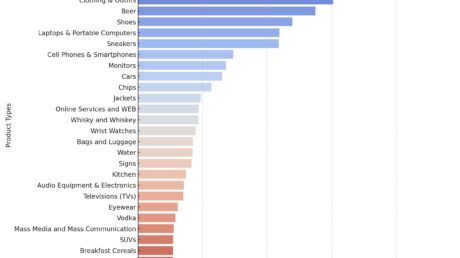YouGov is an international online research data and analytics technology group with over 24 million registered panelists worldwide. Its latest product, YouGov PQS, focuses specifically on helping the product placement industry to understand and value its presence in streaming shows.
YouGov PQS unlocks new possibilities for the product placement industry. It combines a proprietary scoring model with streaming audiences to value product placements, as well as providing insights into the beliefs, habits, and opinions of the audience.
Productplacement.com will be regularly publishing YouGov PQS data, giving insights into the performance of some of the most notable recent product placements to hit streaming platforms.
So, what is YouGov PQS?
YouGov PQS is a new research tool developed for the product placement industry. It enables those involved with product placements to understand their performance more definitively.
It sits under YouGov Stream, YouGov’s solution for streaming audiences. To determine these audiences, YouGov pays its panelists to share their viewership history for platforms such as Netflix and AppleTV+. We then scale these viewership samples to a national level using the renowned scaling methodologies that have made YouGov a global force in research over the last 20 years.
The data shared by these panelists with YouGov is therefore not only zero-party but also verified viewership data. Why is it verified? Because YouGov facilitates panelists sharing their viewership history directly from streaming platforms, meaning we can validate whether the panelist has accessed a given title.
This is a big step forward from many existing research products as it focuses on observed viewership rather than reported viewership (retrospectively surveying people each week on their streaming habits).
YouGov PQS combines audience figures from YouGov Stream with a proprietary model built to evaluate product placements on an instance-by-instance basis, using data taken directly from show footage.
Combining a placement’s score (or Placement Quality Score – PQS for short) with an audience and a market-rate CPT produces a valuation for the placement, which is then contextualized with relevant demographic insights into the placement.
For example, a computer brand may want to know the valuation of a product placement of their laptop in a recent streaming show.
But while the valuation will tell them how the placement performed quantitatively, they may also want some qualitative context to these values.
They might want to know if they reached an audience familiar with their brand, or an audience of a certain income demographic, or something similar.
Or they might even want to answer questions like “How many of those who watched are thinking of buying a new computer in the next 6 months?” and “What kind of devices are they looking to purchase?” There are an almost innumerable number of profiling variables to choose from thanks to YouGov’s long history as a pioneer of online market research.

How does the Placement Quality Scoring model work?
Firstly, a show’s footage is reviewed to picks up all instances of product placement contained within it. Relevant data is then scraped to be fed into the PQS model, which produces the placement’s Placement Quality Score.
The PQS model is built from YouGov panel data on consumer attitudes towards product placement. It has five key factors that together account for plot, screen, and script activation, and each of the five factors are weighted based on their relative importance to consumers.
The result is a model that will score placements highly for things that consumers said would make product placement more effective, and lowly for things that have the opposite effect.
It is a pretty exciting breakthrough because, for years, people in our industry have had to create proxy metrics or engage in expensive custom surveys to try and understand what consumers thought about a product placement.
But the PQS model is a far more efficient means of research.
Why does it work? Because our research found that the levers by which consumers respond to product placements are very consistent.
It makes sense, really. If a product is used in a way that makes it seem like it performs its function well, that is a good thing. If not, that is a bad thing. There are lots of principles like this that stand to reason.
Currently you’d maybe score a product placement for your cereal brand that sees the main character go back for a second serving, then shell out for a costly custom survey that asks “Did you like this placement?” only to get a resounding “Yes” in response. Or you would cobble together some understanding of the audience of the show to try and understand if you at least hit your campaign’s target demographic with it.
But since the levers that drive good and bad product placement are consistent, why not instead ask people what makes product placement good or bad in general, and then abstract the results out into a model reflective of these results? It’s more cost efficient and the resultant Placement Quality Scores and valuations give you tangible results which, in turn, make it far easier to benchmark your activations.

Why is there a need for a tool like this in our industry?
Data from a tool like YouGov PQS is essential for sophisticated decision-making. We believe it’s a game changer for the industry for a few reasons, some of which have been touched on a bit above.
The first is that the dollar valuations are a great way to set targets and measure the ROI of product placement campaigns for brands, and for them to benchmark different campaigns against each other in a way that captures both the reach and the quality of the placements.
The second is that the audience insights that PQS provide can really speak truth to those dollar valuation figures. We’re all used to seeing big reach figures for popular programmes, but without knowing if you’re placing the product with the right audience, the valuation alone risks becoming a vanity metric.
Thirdly, and perhaps most importantly, is the trust between parties engaging in product placement that all this can provide. For agencies who work on behalf of brands to secure product placements, for example, their own ROI studies are naturally taken with a pinch of salt by a brand marketer reading them. Having an independent third party to provide a valuation guarantees impartiality and therefore builds trust.
This combination of quantitative data, demographic insights, and independence, combines to create a really powerful tool that can have a profound effect on strategy, making product placement less of a black box for all involved.
Have any questions, or want to get in touch? Click here to learn more about YouGov PQS and contact the team.
ProductPlacement.com is not affiliated with YouGov. Information is provided for educational purposes only and does not constitute endorsement.




